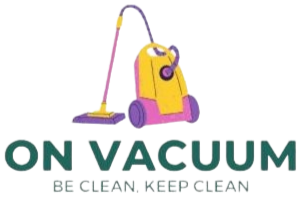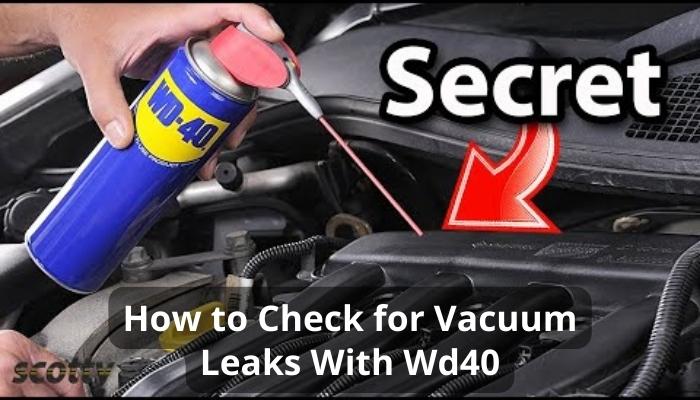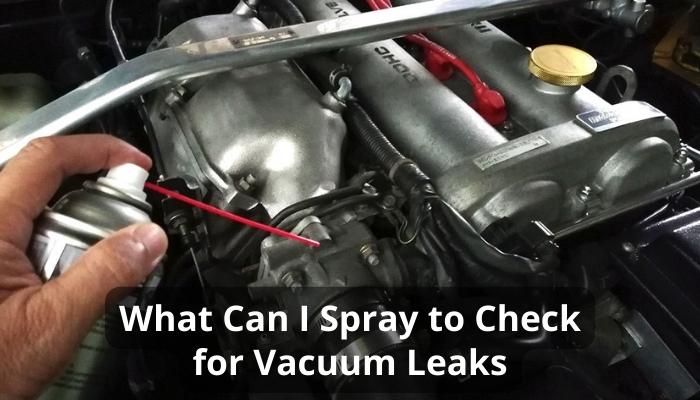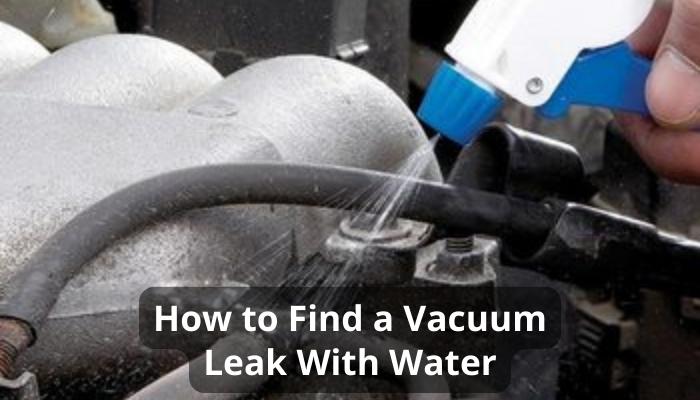Uncover the secrets to easily detecting vacuum leaks using WD-40! Our step-by-step guide offers practical tips, safety precautions, and troubleshooting advice to ensure a hassle-free experience. Dive in to solve your vacuum leak troubles!
What is a Vacuum Leak?
A vacuum leak in a vehicle occurs when air infiltrates the engine. This unaccounted airflow disrupts the air-fuel ratio, leading to numerous performance issues and potential engine damage. Detecting and addressing vacuum leaks is crucial for maintaining the optimal functioning of a vehicle.
Signs and Symptoms of Vacuum Leaks
The primary signs of a vacuum leak include a hissing sound, rough idle, engine misfires, and reduced fuel efficiency. The check engine light might also illuminate, indicating a potential issue that needs immediate attention.
Why WD-40 is a Handy Solution
Properties of WD-40
WD-40 is a renowned multipurpose product with lubricating, degreasing, and water-displacing properties. It effectively penetrates stuck parts, protects metal surfaces, and is excellent for removing grease, grime, and dirt.
Benefits of Using WD-40 for Leak Detection
Using WD-40 for detecting vacuum leaks is beneficial due to its properties. It can help identify the leak source quickly, and its lubricating properties can temporarily seal minor leaks. However, it’s essential to handle WD-40 with care and follow the manufacturer’s guidelines.
Step-by-Step Guide to Detecting Leaks
Preparing Your Vehicle
Before applying WD-40, ensure the vehicle is in a well-ventilated area, the engine is turned off, and it’s cool to the touch. Remove any debris from the engine area and wear protective equipment such as gloves and goggles.
Applying WD-40 Safely
Spray WD-40 on the suspected leak areas while the engine is running. If the engine idle changes, it indicates a vacuum leak. After identifying the leak, please turn off the engine and allow it to cool before performing any repairs.
Tips for Preventing Vacuum Leaks
Regular Maintenance
Regular vehicle maintenance is essential, including checking and replacing damaged hoses and connections. Ensure all connections are tight, and replace any cracked, brittle, or worn components.
Inspecting Hoses and Connections
Regularly inspect hoses and connections for signs of wear and tear. Replacing damaged parts promptly can prevent vacuum leaks and save on costly repairs in the long run.
The Impact of Vacuum Leaks on Vehicle Performance
Decreased Fuel Efficiency
A vehicle experiencing a vacuum leak can suffer from decreased fuel efficiency due to the altered air-fuel ratio, leading to more frequent visits to the gas station and increased expenses.
Reduced Engine Performance
Vacuum leaks can reduce engine performance, causing sluggish acceleration, misfires, and potential long-term damage if not addressed promptly.
Mastering WD-40: Safety and Troubleshooting
Have you ever faced a stubborn bolt that just wouldn’t budge? Or have you encountered a squeaky hinge that grates on your nerves? Enter WD-40, the miracle worker in a can! However, with great power comes great responsibility. Let’s explore the safety precautions and troubleshooting tips to master using WD-40.
Safety Precautions & Tips
Venturing into the world of WD-40? Hold your horses! Before you embark on your fix-it journey, it’s essential to understand the necessary safety precautions and tips.
Safety Measures When Using WD-40
Using WD-40 can be a breeze, but safety should never take a back seat. Here’s what you need to know to stay safe.
Proper Ventilation
Always use WD-40 in a well-ventilated area. The fumes can be harmful, and ensuring proper airflow can mitigate any risks.
Avoiding Fires and Explosions
WD-40 is flammable. Please keep it away from open flames, and avoid spraying it on hot surfaces to prevent unwanted fireworks!
Safe Storage
Store your WD-40 can in a cool, dry place, away from children and pets. Safety first is always safety!
Pro Tips for Effective Leak Detection
Detecting leaks early can save you a ton of trouble. Here are some tips to help you spot them before they get out of hand.
Identifying the Leak Source
Look for signs of leakage around joints and connections. A keen eye can make all the difference!
Testing Methods
Employ various testing methods like pressure tests and soap bubble tests to confirm the presence of a leak.
H4: Preventive Measures
Regular inspections and maintenance can help prevent leaks in the first place. An ounce of prevention is worth a pound of cure!
Read more about How to Hang Dyson V8 on Wall Quickly
Troubleshooting Common Issues
Even the best of us face issues sometimes. Let’s troubleshoot some common problems you might encounter while using WD-40.
Addressing Detected Leaks
Found a leak? Don’t panic! Here’s how you can address it effectively.
Immediate Actions
Turn off the source and contain the leak immediately. Every second counts!
Repair or Replace
Assess the damage and decide whether to repair or replace the affected part. Sometimes, it’s better to start afresh!
What to Do If WD-40 Doesn’t Work?
Sometimes, even WD-40 might meet its match. Here’s what to do when the going gets tough.
Alternative Solutions
Explore alternative solutions like penetrating oils and rust dissolvers. There’s more than one way to skin a cat!
Seeking Professional Help
When in doubt, seek professional help. There’s no shame in calling in the experts!
In conclusion, WD-40 can be a handy companion in dealing with various issues around the house or workshop. However, it is crucial to use it safely and know how to troubleshoot common problems effectively. Following the safety measures and tips outlined above can ensure a smooth and safe experience with WD-40.
Conclusion
Detecting and addressing vacuum leaks is essential for maintaining a vehicle’s performance and longevity. WD-40 can be a handy solution for detecting leaks. Still, using it safely and following the manufacturer’s guidelines is important. Regular maintenance and vigilance can help prevent vacuum leaks and ensure the smooth operation of your vehicle.
FAQs
Can WD-40 be used on all surfaces?
While WD-40 is versatile, it’s essential to check the manufacturer’s guidelines for suitability on different surfaces.
Is WD-40 harmful to the skin?
Direct contact with skin should be avoided. If exposure occurs, wash the area thoroughly with soap and water.
What should I do if I inhale WD-40 fumes?
Move to fresh air immediately and seek medical attention if symptoms persist.
Can WD-40 remove rust?
Yes, WD-40 can help break down rust and is useful for loosening rusted parts.
Is there a difference between WD-40 and penetrating oil?
While both have similar uses, penetrating oils are specifically formulated to penetrate and loosen rusted or stuck parts.
Can WD-40 permanently fix a vacuum leak?
No, WD-40 can help detect a vacuum leak, but it’s not a permanent solution. Proper repairs are needed to fix the leak.
Is it safe to use WD-40 on all engine parts?
Following the manufacturer’s guidelines and using WD-40 safely, avoid sensitive components like oxygen sensors and catalytic converters.
How often should I inspect my vehicle for vacuum leaks?
Regular inspections can help detect and address vacuum leaks early, especially during routine maintenance.
Can I fix a vacuum leak myself?
While minor leaks can sometimes be fixed by individuals with automotive knowledge, it’s often best to consult a professional mechanic for proper diagnosis and repair.






